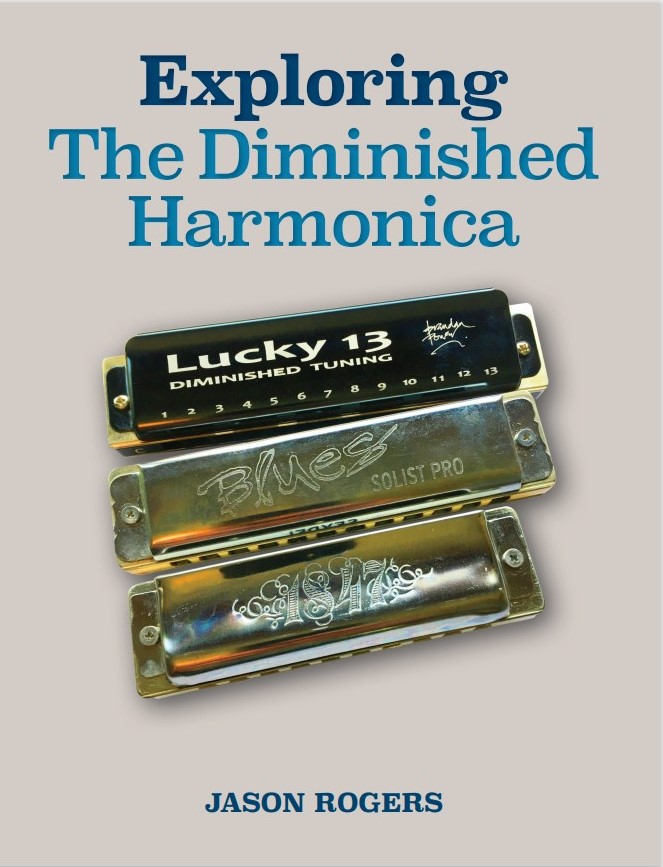HOME![]() DIMINISHED HARMONICA
DIMINISHED HARMONICA![]() DIMINISHED CHROMATIC HARMONICA
DIMINISHED CHROMATIC HARMONICA![]() TIMELINE
TIMELINE![]() BLOG
BLOG![]() BIO
BIO![]() LINKS
LINKS![]() CONTACT
CONTACT

The diminished harmonica is built on the same concept as the traditional 10-hole diatonic harmonica, which is also known as the blues harp. The blues harp is played by a diverse range of musicians such as Little Walter, Bob Dylan, Charlie McCoy, John Popper, and Howard Levy.
The harmonica is a rare instrument in that you can relatively easily change the pitch layout to suit your imagination; The diminished harmonica is a blues harp with an alternate tone layout. An analogy might be that of a typewriter with an alternate keyboard layout that is an improvement on the traditional qwerty layout.
The diminished harmonica is (most typically) built upon two diminished 7th chords a whole step apart. One is a blow chord and one a draw chord. This results in a blow/draw whole step in each hole, with a half step interval between the draw of one hole and the blow of the next. This creates a repeating, symmetrical tone layout across the harmonica. This pattern is consistent throughout all ranges of the harmonica, which is not true of the blues harp.
| draw | D | F | Ab | B |
| blow | C | Eb | Gb | A |
One main characteristic of the "Dimi" (a nickname for the diminished harmonica) is that a fully chromatic scale can be played with the simplest of bends: the half-step draw bend.
| draw | D | F | Ab | B |
| draw bend | Db | E | G | Bb |
| blow | C | Eb | Gb | A |
Playing the Dimi will make you a better musician and a better harmonica player; You will find you will be able to play ideas that are difficult on the blues harp. This is because all notes are available as either a blow note, a draw note, or as a simple-half step draw bend. Playing the Dimi will break you out of old patterns, licks, and ruts. It will free your mind and ear to play things that don't naturally come out on the blues harp.
It is easy to play by ear on the Dimi. Start on any note, and you'll be able to play your ideas from that starting note because all keys are equally easy. No matter what key you find yourself in, you're certain to be familiar with fingerings for that key; I say this because all 12 keys are played with only three unique fingering patterns. In addition, every octave is the same, making finding your way around the Dimi easy!
The Dimi is a great tool for learning theory!
Want to learn all your major scales? They are equally playable in any key.
Want to learn more advanced altered scales? The following scales (in some keys) can each be played with one half-step draw bend only:
The Dimi is an amazing harmonica layout. Every harmonica player should have at least one Dimi in their case. I recommend using my book as a guide to getting started:

Here's a quick demo of the "Ain't That Right Scale" as found in the start of the book.
Brendan Power demonstrates three patterns for all keys:
Brendan Power demonstrates chromatics on the Dimi:
Alfred Hirsch plays "Take Five" on the Dimi. Alfred's solo is transcribed in "Exploring the Diminished Harmonica".
Here's a very cool rendition of Soundgarden's "Black Hole Sun" played by Alfred Hirsch on diminished harmonica and acoustic fingerstyle guitar.
Ed Coogan plays the Dimi on his composition "In Harm's Way". Ed demonstrates his mastery of the Type II harmonic minor, the chromatic scale, the Type II minor blues scale, a soulful vibrato that seems to bridge blues, jazz, and rock, and more. This is transcribed for you in "Exploring the Diminished Harmonica".
Sound clip of "In Harm's Way," by Ed Coogan